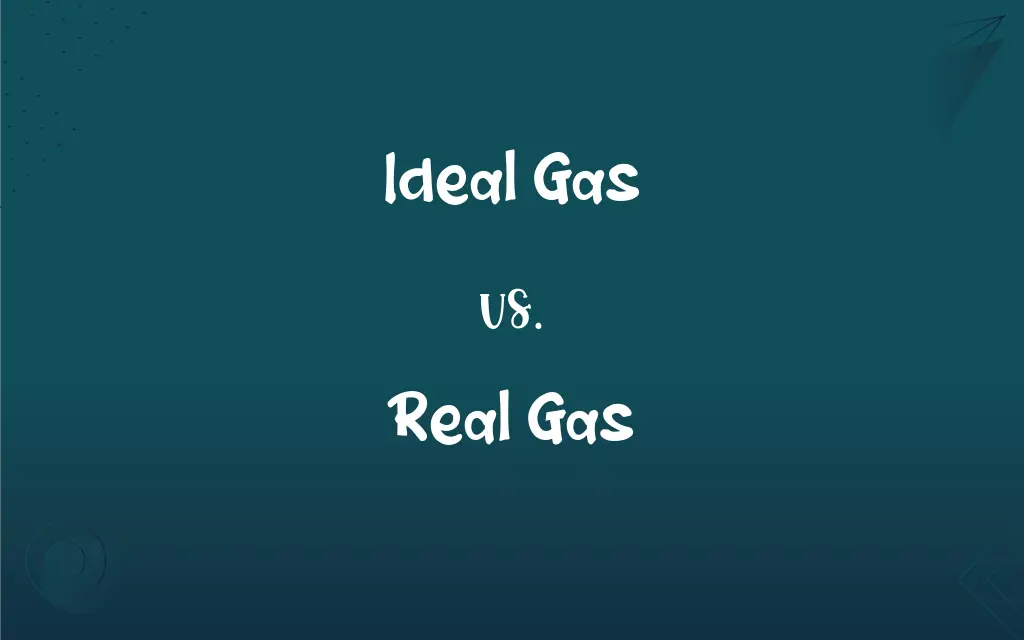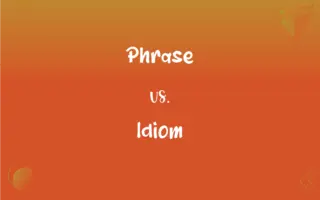Ideal Gas vs. Real Gas: What's the Difference?
Edited by Aimie Carlson || By Janet White || Published on January 5, 2024
An ideal gas is a theoretical gas that perfectly follows the gas laws under all conditions, while a real gas exhibits deviations from these laws under high pressure or low temperature.

Key Differences
An ideal gas is a hypothetical concept in which gas molecules do not interact with each other and the volume of gas particles is negligible compared to the volume it occupies. In contrast, real gases have intermolecular forces and the volume of the particles is significant, especially under high pressure or low temperature.
Ideal gases perfectly obey the Ideal Gas Law (PV=nRT), where P is pressure, V is volume, n is the amount of substance, R is the gas constant, and T is temperature. Real gases, however, deviate from the Ideal Gas Law under extreme conditions due to particle interactions and size.
In ideal gases, collisions between particles are perfectly elastic, meaning there is no loss of kinetic energy during collisions. Real gases have inelastic collisions under certain conditions, with energy loss due to intermolecular forces.
The behavior of ideal gases is often used as a model in physics and chemistry because it simplifies calculations and understanding of gas behavior. Real gases more accurately represent the behavior of gases in practical, real-world conditions, although they are more complex to model.
At standard temperature and pressure (STP), real gases often behave similarly to ideal gases, but as conditions deviate from STP, differences in behavior become more pronounced.
ADVERTISEMENT
Comparison Chart
Intermolecular Forces
No intermolecular forces
Intermolecular forces present
Compliance with Gas Laws
Always follows Ideal Gas Law
Deviates from Ideal Gas Law under extreme conditions
Particle Volume
Negligible particle volume
Particle volume is significant under high pressure
Collision Nature
Elastic collisions
Inelastic collisions possible under certain conditions
Behavior under STP
Behaves according to theory
Behaves similarly to ideal gas but with slight deviations
ADVERTISEMENT
Ideal Gas and Real Gas Definitions
Ideal Gas
Collisions between ideal gas particles are perfectly elastic.
In an ideal gas, the total kinetic energy is conserved during particle collisions.
Real Gas
A real gas is a gas that exhibits deviations from ideal behavior, especially under high pressure or low temperature.
At high pressures, the behavior of real gases significantly deviates from that predicted by the Ideal Gas Law.
Ideal Gas
It perfectly follows the Ideal Gas Law under all conditions.
Ideal gas behavior is a useful approximation in many chemical reactions.
Real Gas
It has intermolecular forces and particle volume that affect its properties.
The liquefaction of real gases is due to the presence of intermolecular attractions.
Ideal Gas
Ideal gases are used as models to simplify gas behavior in physics.
The behavior of an ideal gas is foundational in understanding real gas properties.
Real Gas
Real gases are actual gases as they exist in nature.
The study of real gases helps in understanding atmospheric phenomena.
Ideal Gas
Ideal gas particles are considered point particles with no volume.
The concept of an ideal gas simplifies the study of gases in thermodynamics.
Real Gas
Real gases do not perfectly follow the Ideal Gas Law.
Real gases like oxygen and nitrogen exhibit ideal behavior only at certain temperatures and pressures.
Ideal Gas
An ideal gas is a hypothetical gas with no intermolecular forces and negligible volume.
In ideal gas theory, gases expand infinitely when heated at constant pressure.
Real Gas
Their behavior becomes more ideal-like at high temperature and low pressure.
At low pressures, the volume of a real gas approaches that predicted for an ideal gas.
FAQs
What is the Ideal Gas Law?
The Ideal Gas Law is PV = nRT, relating pressure, volume, number of moles, and temperature.
Does an ideal gas exist?
No, it's an idealization for simplicity in physics and chemistry calculations.
Why study ideal gases?
They provide a simplified model to understand gas behavior.
Can real gases be compressed?
Yes, unlike ideal gases, they can be compressed.
Can real gases behave like ideal gases?
Yes, many real gases approximate ideal gas behavior under certain conditions.
Is air an ideal gas?
Air can be approximated as an ideal gas under normal conditions.
Are ideal gas calculations accurate?
They are accurate under conditions of low pressure and high temperature.
Why do real gases deviate from ideal behavior?
Due to intermolecular forces and the volume occupied by gas molecules.
What is an ideal gas?
An ideal gas is a theoretical gas whose molecules do not interact and occupy no volume.
What assumptions are made for ideal gases?
No intermolecular forces and molecules occupy no volume.
Are real gas effects significant in everyday life?
Usually not under normal conditions, but in industrial processes, they can be important.
How does temperature affect ideal gases?
Their volume and pressure increase with temperature.
What are the limitations of the ideal gas model?
It fails at very high pressure and low temperature.
How does pressure affect real gases?
High pressure can significantly change their volume and behavior.
How do real gases behave at very low temperatures?
They can liquefy or solidify, deviating significantly from ideal gas behavior.
What is a real gas?
A real gas is an actual gas that has volume and intermolecular forces.
How do real gases differ from ideal gases?
Real gases deviate from the Ideal Gas Law, especially at high pressure and low temperature.
Are all gases real gases?
Yes, all gases that actually exist are real gases.
Do real gases always follow the Ideal Gas Law?
No, they often deviate from it under certain conditions.
What is the van der Waals equation?
It's a modified Ideal Gas Law that accounts for volume and intermolecular forces in real gases.
About Author
Written by
Janet WhiteJanet White has been an esteemed writer and blogger for Difference Wiki. Holding a Master's degree in Science and Medical Journalism from the prestigious Boston University, she has consistently demonstrated her expertise and passion for her field. When she's not immersed in her work, Janet relishes her time exercising, delving into a good book, and cherishing moments with friends and family.
Edited by
Aimie CarlsonAimie Carlson, holding a master's degree in English literature, is a fervent English language enthusiast. She lends her writing talents to Difference Wiki, a prominent website that specializes in comparisons, offering readers insightful analyses that both captivate and inform.































































